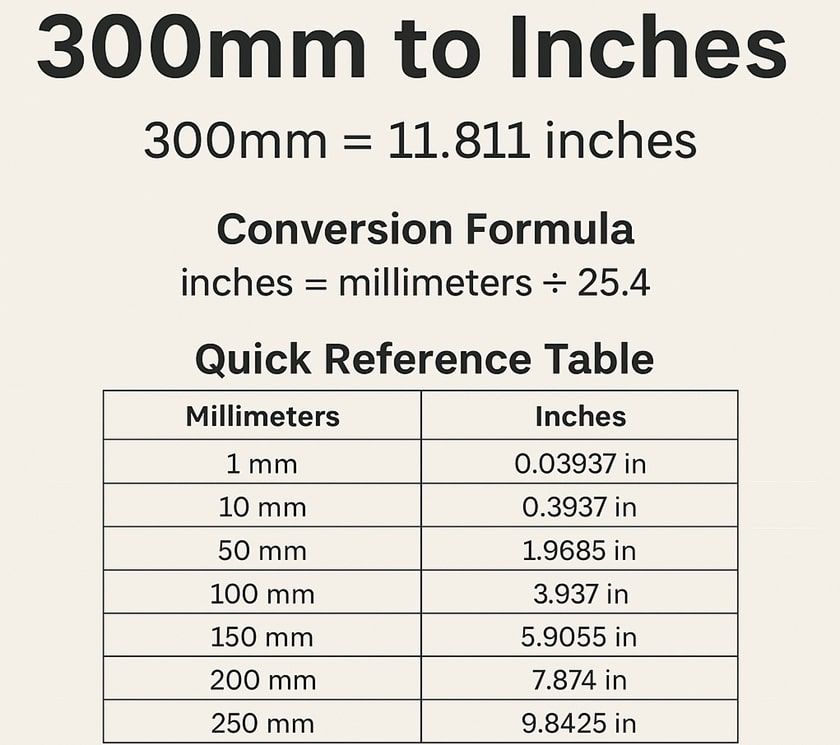Understanding measurements across systems can help in everyday tasks and technical work. You might need to convert millimeters to inches during tasks involving tools, electronics, or technical drawings. Some people mistakenly believe that 300mm is equal to exactly 12 inches.
That assumption is wrong. The correct conversion involves a precise formula, and this guide explains it clearly.
What Is 300mm in Inches?
A direct conversion gives the result:
300mm = 11.811 inches
This value uses the standard conversion factor between millimeters and inches.
Conversion Formula
To convert millimeters (mm) to inches (in), divide the millimeter value by 25.4.
Formula:inches = millimeters ÷ 25.4
So:300 ÷ 25.4 = 11.811 inches
Another way to remember it:
1 mm = 0.03937 inches
You can use this simple table to check other conversions.
| Millimeters | Inches |
|---|---|
| 1 mm | 0.03937 in |
| 10 mm | 0.3937 in |
| 50 mm | 1.9685 in |
| 100 mm | 3.937 in |
| 150 mm | 5.9055 in |
| 200 mm | 7.874 in |
| 250 mm | 9.8425 in |
| 300 mm | 11.811 in |
Fractional Inches Table
Sometimes, you may see inches in fractions. Here are a few examples:
| Fraction (inches) | Millimeters |
|---|---|
| 1/2 in | 12.7 mm |
| 1 in | 25.4 mm |
| 2 in | 50.8 mm |
| 5 in | 127 mm |
| 12 in | 304.8 mm |
This table helps when comparing metric and imperial measurements side by side.
Common Misconception
Some people believe a 300mm wafer or object equals 12 inches. That belief is incorrect. 300mm is slightly less than 12 inches. A full 12-inch measurement equals 304.8mm. Always check with a calculator or conversion tool when exact numbers matter.
Why Use Millimeters Instead of Inches?
Millimeters give more accurate measurements. Engineers, scientists, and designers often prefer metric units because they are based on decimals, making calculations simple. Metric tools are common in international manufacturing and product design.
Why Use Inches Instead of Millimeters?
Inches are more common in the United States and some parts of the UK and Canada. They are used in construction, home projects, and everyday tasks. For example, screen sizes, furniture, and body measurements often use inches.
How to Convert Using a Chart
Look across the row for the whole inches and then follow the column for the fraction. For example, 5 3/8 inches = 137mm.
Using Online Tools
Several websites offer instant conversion tools. You can enter a number in millimeters or inches and get the result in real time. Many tools also show the result in both decimal and fraction format.
Key Facts to Remember
-
1 inch = 25.4 mm
-
1 mm = 0.03937 in
-
300 mm = 11.811 in
-
12 inches = 304.8 mm
Closing Note
Converting 300mm to inches is simple. You don’t need advanced tools to convert measurements. A quick check using the formula or table will do the job. Always round your results only when precision is not critical. For technical tasks, use exact numbers.
Let me know if you want a downloadable version or a visual chart for your site.

